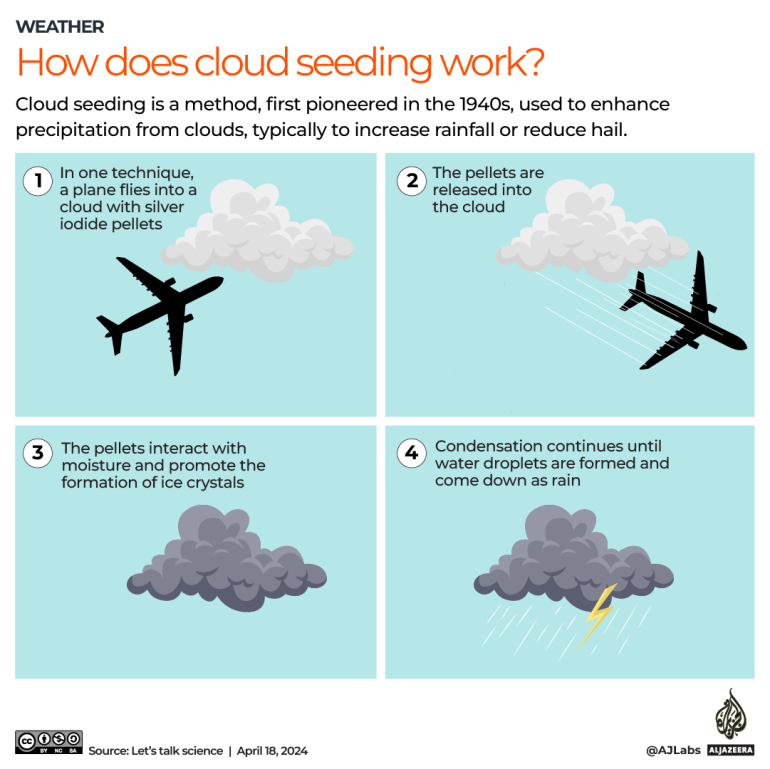In a spectacular transformation that has caught the attention of environmentalists, locals, and global onlookers alike, the arid deserts of Saudi Arabia are morphing into verdant landscapes. This phenomenon, primarily attributed to a series of heavy rains hitting the region, symbolizes a dramatic shift in the ecological dynamics of an area famously known for its dry, inhospitable terrain. Here, we delve deep into this environmental spectacle, exploring its implications and the reasons behind such an extraordinary change.
 Pin
Pin A picture taken on August 22, 2023 shows lightning over Mecca’s clock tower in Saudi Arabia. — AFP
Table of Contents
The Greening of the Desert
Traditionally, Saudi Arabia’s landscape has been dominated by vast expanses of desert, with the Arabian Desert covering most of the country. However, recent climatic changes have led to an unprecedented amount of rainfall across various parts of the Kingdom, leading to what can only be described as a miraculous transformation.
Regions once characterized by sand dunes are now blooming with life, showcasing a rich tapestry of flora that seemed unimaginable in such a setting. The visual evidence of this transformation is not just stunning but serves as a potent reminder of nature’s resilience and adaptability.
Understanding the Phenomenon
The sudden increase in rainfall in Saudi Arabia is part of a broader pattern of shifting weather conditions across the globe. Climate scientists point towards global warming and shifts in weather patterns as the main drivers behind the increased precipitation in desert regions. These rains, while beneficial in the short term for the arid landscapes, also raise concerns about their long-term implications on the region’s environment and its inhabitants.
Ecological and Societal Impact
The greening of the deserts brings with it a mix of ecological benefits and challenges. On the one hand, the increase in vegetation can lead to improved air quality, soil stabilization, and even the potential for increased biodiversity. It offers a glimpse into how desert regions can be transformed with adequate water resources, serving as a model for combating desertification.
On the societal front, the phenomenon could have significant implications for agriculture and water resources in the region. The possibility of cultivating previously barren lands could lead to food production opportunities, significantly impacting local communities and economies.
However, there is also a cautionary note to be considered. The sudden change in landscape and potential for increased vegetation could alter the habitat and ecological balance, potentially leading to unforeseen environmental consequences.
A Sign of Things to Come?
While the greening of Saudi Arabia’s desert is a welcome sight, it also raises important questions about the future. How will these climatic changes impact the region and the planet in the long run? Are we witnessing a temporary anomaly, or is this a sign of a more permanent shift in the earth’s climatic system?
Environmental and Ecological Implications
- Biodiversity Boost: The sudden availability of water creates conditions conducive to life. Seeds of various plants that have lain dormant in the soil for years, awaiting moisture, begin to germinate and bloom. This not only transforms the landscape visually but also supports a variety of insects, birds, and other wildlife, enhancing local biodiversity.
- Water Recharge: Heavy rains contribute to the replenishment of underground aquifers, which are vital for the desert’s ecosystem and the human populations that rely on them for fresh water. In a region where water scarcity is a significant concern, this recharge is essential.
- Flash Floods and Soil Erosion: On the flip side, the desert terrain, with its hard, compacted soil, is not well-equipped to absorb vast amounts of water quickly. This leads to flash floods, which can cause destruction of infrastructure and pose risks to human life. Additionally, the intense flow of water can lead to soil erosion, stripping the land of its topsoil and affecting future plant growth.
Social and Economic Impacts
- Agricultural Opportunities: The green landscapes open up temporary opportunities for grazing and agriculture in areas that are usually barren. This can be a boon for local farmers and herders, offering them a seasonal abundance.
- Tourism: The transformation of deserts into green landscapes can attract tourists, curious to witness this unusual sight. This can provide a temporary boost to local economies.
- Sustainability Questions: While the green deserts may seem like a boon, they also raise questions about sustainability and water management. In regions where water is scarce, managing this resource wisely, considering the long-term impacts of such anomalies, is crucial.
Climate Change Considerations
The increasing frequency of heavy rains and the greening of deserts in Saudi Arabia and similar regions may also be indicators of broader climate change impacts. These changes prompt a reevaluation of water management strategies, agricultural practices, and disaster preparedness plans to adapt to the new normal.
The transformation of Saudi Arabia’s deserts into lush landscapes is a testament to nature’s unpredictable power. While it brings temporary benefits and a boost to biodiversity, it also highlights the importance of sustainable environmental management and the need to adapt to changing climate patterns.
Understanding the Record Rainfall and Flooding in the UAE and Oman
On a day that might be remembered for years to come, the United Arab Emirates (UAE), particularly its largest city, Dubai, found itself grappling with an unparalleled natural disaster. Following record-breaking rainfall on Tuesday, the city experienced devastating floods, with the deluge seemingly consuming everything in its path. The storm poured more than a year’s worth of rain over the city and its surroundings in just a matter of hours, leaving the urban infrastructure overwhelmed.
The flooding wreaked havoc on the city’s roads, and even the bustling Dubai International Airport was not left untouched. The scenes of chaos echoed the vulnerability of even the most developed urban landscapes to the forces of nature. Dubai, renowned for its futuristic skyline and sprawling desert, was unrecognizable, transformed into an aquatic labyrinth by the relentless rains.
The storm’s effects were not confined to the UAE alone. Neighboring Oman also faced the fury of the weather, with significant rainfall causing flooding and leading to the tragic loss of at least 20 lives. The sudden and intense nature of the downpour prompted speculation and concern among the public and on social media. Many pointed to cloud seeding — a technique employed by the UAE to enhance precipitation — as a potential cause for the unprecedented rainfall.
However, experts are leaning towards a different explanation: climate change. Climate scientists have noted a significant increase in extreme weather events around the globe, attributing these anomalies to the rapidly changing climate. With the planet warming, the atmosphere is holding more moisture, leading to more significant and more intense rainfall events. This explanation offers a broader context to the disaster, situating it within the global crisis of climate change, rather than attributing it to local practices like cloud seeding.
The record rainfall and subsequent flooding in the UAE and Oman highlight the increasing occurrence of extreme weather events as a consequence of climate change. While cloud seeding might have contributed to the situation, the larger issue at hand is the global climate crisis. As countries around the world grapple with similar challenges, this event serves as a potent reminder of the urgent need for climate action and adaptation strategies to mitigate the impact of such disasters in the future.
Historic Deluge in the Desert: The Storm that Transformed the UAE and Oman
In an unprecedented turn of events, the usually sun-drenched landscapes of the United Arab Emirates (UAE) and Oman were transformed into scenes more akin to waterlogged realms. This dramatic shift was ushered in by a potent storm that embarked on its watery siege in Oman on a calm Sunday, only to unleash its full fury upon the UAE come Tuesday. This was no ordinary rainfall; it was a deluge powerful enough to disrupt the rhythm of daily life, causing flights to be grounded, electricity to falter, and streets to be submerged.
Dubai, a city famed for its architectural wonders and bustling life, found itself grappling with the chaos of inundated homes, snarled traffic, and residents trapped within their abodes. The spectacle of water prevailing in a place where sun is king was nothing short of historic. According to the state-run WAM news agency, the event marked “a historic weather event,” one that eclipsed all prior records since they began in 1949. Remarkably, this was a period before the discovery of crude oil in the Gulf, hallmarking a time when the landscape of the region was about to undergo a monumental transformation.
Dubai, with its population exceeding three million souls, was drenched in more than 142mm (5.59 inches) of rain, dwarfing the roughly 76mm (3 inches) expected annually and inundating Dubai International Airport with close to 127mm (5 inches). Meanwhile, Oman was not spared, as it received an astonishing 230mm (9 inches) of rain from Sunday to Wednesday, shattering the average annual expectation of around 100mm (4 inches) in the capital, Muscat.
This extraordinary meteorological event did not limit its spectacle to Oman and the UAE. Neighboring nations such as Bahrain, Qatar, and Saudi Arabia also experienced their share of the skies’ unexpected bounty. This deluge will be remembered as a stark reminder of the power of nature, capable of transforming arid deserts and bustling metropolises alike into chapters of a story where water, not sand nor sun, was the protagonist.
Rain From the Heavens or Human Hands? The Mystery Behind Dubai's Unexpected Deluge
In the bustling city of Dubai, where skyscrapers pierce the cerulean sky and the desert sun reigns supreme, an intriguing theory emerged from the unexpected opening of the heavens. The sudden downpour that drenched the city sparked widespread speculation, with fingers pointing towards the ambitious art of cloud seeding as the culprit behind the rains. Fueling these rumors were reports citing meteorologists from the UAE’s National Centre for Meteorology (NCM), who disclosed that Dubai had launched six to seven cloud-seeding missions prior to the deluge. The Associated Press further added to the intrigue by revealing flight-tracking data of an aircraft linked to the UAE’s cloud seeding operations, tracing its aerial dance across the country’s airspace on the day before the rains commenced.
Cloud seeding, a practice the UAE has dabbled in since the 1990s, aims to address the stark water scarcity by coaxing the sky into generosity. The country, with its arid embrace, seldom witnesses rainfall, turning every drop into a precious treasure. With the backdrop of a landscape more accustomed to scorching temperatures that can leap over 50 degrees Celsius (122 degrees Fahrenheit), the sudden showers seemed nothing short of miraculous.
However, amid the swirling rumors, the NCM sought to dispel the cloud of misunderstanding. Confirming the operations took place on Sunday and Monday, but emphatically denying any interventions on Tuesday, the day of the rainfall. Omar Al Yazeedi, the deputy director general of the NCM, clarified the situation to the NBC news agency, explaining that cloud seeding targets clouds in their nascent stages. “If you have a severe thunderstorm situation, then it is too late to conduct any seeding operation,” he remarked, shedding light on the complex nuances of weather modification.
Despite the curiosity and controversies, the rain served as a reminder of the UAE’s vulnerability to the elements, highlighting the absence of sufficient drainage systems to manage such unexpected gifts from the sky. Roads submerged under water vividly illustrated the challenges that lie in taming nature’s whims, even as the nation continues to pioneer innovative approaches to coax life into its arid heartland.
Is the recent deluge a consequence of climate change? Experts and officials have dispelled rumors attributing the heavy rainfall to cloud seeding efforts.
“Should cloud seeding be the cause, areas would perpetually be drenched. It’s not feasible to conjure 6 inches [152.4mm] of rain out of nowhere,” remarked Ryan Maue, ex-chief scientist at the US National Oceanic and Atmospheric Administration.
Rather, the torrential downpours are attributed to a typical weather pattern, intensified by the effects of climate change. According to Mark Howden, director at The Australian National University’s Institute for Climate, Energy, and Disaster Solutions, the phenomenon is due to extraordinarily warm sea waters around Dubai and the hot air above it.
“This leads to increased evaporation rates and the atmosphere’s ability to retain moisture, culminating in significant rainfall events like the one witnessed in Dubai,” he explained.
Reports indicate that the heavy rainfall was caused by a slow-moving storm traversing the Arabian Peninsula towards the Gulf of Oman over several days. This storm picked up vast amounts of tropical moisture near the equator and unleashed it over the affected areas.
Forecasts had anticipated the storm’s arrival days before it struck.
Such mammoth tropical storms are not unheard of in the Middle East, points out Suzanne Gray, a meteorology professor at the University of Reading. She referenced a study that identified nearly 100 similar occurrences across the southern Arabian Peninsula between 2000 and 2020, notably a March 2016 storm that unleashed nearly 240mm of rain on Dubai within hours. Climate scientists argue that the upswing in global temperatures, driven by anthropogenic climate change, is resulting in increased frequency and severity of extreme weather events globally, including heavy rainfall.
“Thunderstorm-induced rainfall, like the recent ones in the UAE, tends to significantly increase with the planet’s rising temperatures,” they note.
Summoning the Skies: The Science and Controversy of Cloud Seeding in Weather Modification
 Pin
Pin Cloud seeding unravels as an intriguing chapter in the saga of weather modification, designed primarily to coax more rain or snow from the skies. This process doesn’t conjure moisture from nowhere; it operates on the principle that water vapor needs a dance partner to step into the tangible world as precipitation. The tiny particles playing cupid in this atmospheric ballet are known as condensation nuclei, essential for coaxing moisture to condense and cloud droplets to form.
By deploying aircraft and ground-operated artillery, cloud seeding injects these microscopic matchmakers — often in the form of silver iodide or dry ice — into clouds, providing the essential platforms for moisture to gather. As these particles accumulate more water, they reach a critical mass and descend as precipitation. This alchemy of turning aerosolized particles into rainfall or snowflakes is not just an act of nature but a carefully choreographed intervention.
Although the concept might sound like a modern miracle, it’s grounded in techniques pioneered back in the 1940s. However, it’s not a magical cure-all for drought; it requires existing clouds with some moisture content as its canvas. While it has been embraced by about 50 countries across the globe — from the arid expanses of the United States and UAE to the expansive territories of China and Australia — the effectiveness and environmental impact of cloud seeding are topics of ongoing debate within the scientific community.
Regions parched by drought, particularly in the Western United States and countries like the UAE, have looked towards cloud seeding with both hope and investment, aiming to conjure precious rain. The U.S. Bureau of Reclamation, for instance, allocated $2.4 million to cloud seeding efforts along the Colorado River last year, and Utah has significantly ramped up its budget for similar initiatives.
China, notable for its strategic application of cloud seeding for agriculture and to ensure clear skies for the 2008 Beijing Olympics, signifies the global interest and diverse applications of this weather modification method. Despite its controversies and the ongoing conversations about its true efficacy and potential environmental impacts, cloud seeding remains a beacon of hope against the backdrop of climate variability and water scarcity.
































